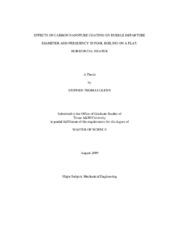| dc.contributor.advisor | Banerjee, Debjyoti | |
| dc.creator | Glenn, Stephen T. | |
| dc.date.accessioned | 2011-08-08T22:47:25Z | |
| dc.date.accessioned | 2011-08-09T01:29:47Z | |
| dc.date.available | 2011-08-08T22:47:25Z | |
| dc.date.available | 2011-08-09T01:29:47Z | |
| dc.date.created | 2009-08 | |
| dc.date.issued | 2011-08-08 | |
| dc.date.submitted | August 2009 | |
| dc.identifier.uri | https://hdl.handle.net/1969.1/ETD-TAMU-2009-08-7058 | |
| dc.description.abstract | The effects of a carbon nanotube (CNT) coating on bubble departure diameter and frequency in pool boiling experiments was investigated and compared to those on a bare silicon wafer. The pool boiling experiments were performed at liquid subcooling of 10 degrees Celsius and 20 degrees Celsius using PF-5060 as the test fluid and at atmospheric pressure. High-speed digital image acquisition techniques were used to perform hydrodynamic measurements. Boiling curves obtained from the experiments showed that the CNT coating enhanced critical heat flux (CHF) by 63% at 10 degrees Celsius subcooling. The CHF condition was not measured for the CNT sample at 20 degrees Celsius subcooling. Boiling incipience superheat for the CNT-coated surface is shown to be much lower than predicted by Hsu's hypothesis. It is proposed that bubble nucleation occurs within irregularities at the surface of the CNT coating. The irregularities could provide larger cavities than are available between individual nanotubes of the CNT coating.
Measurements from high-speed imaging showed that the average bubble departing from the CNT coating in the nucleate boiling regime (excluding the much larger bubbles observed near CHF) was about 75% smaller (0.26 mm versus 1.01 mm)and had a departure frequency that was about 70% higher (50.46 Hz versus 30.10 Hz). The reduction in departure diameter is explained as a change in the configuration of the contact line, although further study is required. The increase in frequency is a consequence of the smaller bubbles, which require less time to grow. It is suggested that nucleation site density for the CNT coating must drastically increase to compensate for the smaller departure diameters if the rate of vapor creation is similar to or greater than that of a bare silicon surface. | en |
| dc.format.mimetype | application/pdf | |
| dc.language.iso | en_US | |
| dc.subject | pool boiling | en |
| dc.subject | carbon nanotube | en |
| dc.subject | bubble departure diameter | en |
| dc.subject | bubble departure frequency | en |
| dc.subject | subcooled | en |
| dc.title | Effects of Carbon Nanotube Coating on Bubble Departure Diameter and Frequency in Pool Boiling on a Flat, Horizontal Heater | en |
| dc.type | Thesis | en |
| thesis.degree.department | Mechanical Engineering | en |
| thesis.degree.discipline | Mechanical Engineering | en |
| thesis.degree.grantor | Texas A&M University | en |
| thesis.degree.name | Master of Science | en |
| thesis.degree.level | Masters | en |
| dc.contributor.committeeMember | Best, Frederick | |
| dc.contributor.committeeMember | Entesari, Kamran | |
| dc.contributor.committeeMember | Lalk, Thomas | |
| dc.type.genre | thesis | en |
| dc.type.material | text | en |


